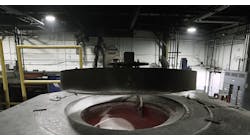Transforming Waste Into Value
Megacasting to Start at Honda
Partnership Boosts Melt Capacity by 30%
Optimizing Aluminum Melt Quality
Diecaster is Rebranding and Investing
Nothing is more frustrating in foundry operations than finding an outbreak of subsurface porosity after costly machining operations. Outbreaks of subsurface porosity always seem to occur during high humidity seasons, especially during the rainy spring. The prime culprit universally blamed is hydrogen absorption into molten steels.
The hydrogen atom is the smallest and simplest of all the elements. Hydrogen can be absorbed only in its mono-atomic state. Nitrogen also can play a significant role in the development of porosity, especially in the production of high-alloy steel castings.
Hydrogen and nitrogen absorption in steel casting may result from alloy additions and reactions at the mold-metal interface. The ability of molten steel to absorb large amounts of hydrogen and nitrogen is shown in Figure 1.
Molten steels can readily absorb both hydrogen and nitrogen in excess of their solubility limits. When a casting containing elevated hydrogen and nitrogen levels solidifies, subsurface porosity will result. Hydrogen pickup may occur from almost any source of moisture, such as refractories, green sand molds, chemical mold- and core-binder decomposition, slag additives, and atmospheric humidity. Nitrogen pickup can result from ferroalloy additions as well as decomposition products from chemical mold and core binders. Figure 2 illustrates typical subsurface pinholes in a high-alloy steel casting.
Mold-Metal Interface Reactions. With few exceptions, core and mold binders used in steel foundries industry are organically based, meaning on carbon, hydrogen, and oxygen, and in some cases nitrogen. The approximate chemical make-up of some of the common binder systems is shown in Table 1 (a typical, Western bentonite, bonded green sand is shown for comparison.)
At ferrous casting temperatures, the presence of these elements (carbon, hydrogen, oxygen and nitrogen) and their subsequent decomposition products can produce a variety of casting defects.
Hydrogen can be absorbed into molten steel from moisture in atmosphere and refractory materials, deoxidation and alloying elements, and slag additives. Nitrogen also can readily be absorbed in molten steels from gaseous decomposition products from mold and core binders as well as certain charge materials. Roach and Simmons(2) reported that all stainless steels will tend to pick up nitrogen when melted in air.
Alloying Materials. The solubility of nitrogen in chromium alloys can be quite high, unless the foundry specifies the need for a low-nitrogen ferrochrome grade. In one reported instance, a stainless steel foundry was experiencing severe subsurface porosity and upon further investigation, it was found that low-carbon ferrochrome being used contained over 10,000 ppm (1.0%) nitrogen. Nitrogen and hydrogen also are very soluble in manganese alloys, so great care must be taken to specify low-hydrogen and nitrogen grades, particularly with electrolytic grades of manganese metal. Hydrogen also has been found in electrolytic nickel cathode squares.
Porosity in High-Alloy Steels. Research conducted in the late 1960s identified that the use of ferroselenium can substantially eliminate subsurface porosity in green-sand molds(3). At the time of the research, chemical binder technology was in its infancy so none of binders systems shown in Table 1 were investigated. However, it has since been found that the addition of ferroselenium also can be effective when using chemically bonded sand.
One of the primary uses of ferroselenium in metalcasting is to control hydrogen porosity. Small amounts of FeSe can virtually eliminate hydrogen porosity (pinholes) in carbon, medium-, and high-alloy cast steels, wear-resistant iron castings such as Ni Resist, and stainless steels poured in green sand or chemically bonded molds. Typical addition rates are 0.005% Se to 0.02% Se (0.10 lbs to 0.40 lb per ton) but as much as 1 lb. per ton can be added.
FeSe additions at Foundry X. To illustrate how effective FeSe additions were to a high chrome-nickel alloy valve casting (nominally 1.6% C, 21% Cr, 6% Mn, 4% Ni, 0.2% N) is shown in this example from Foundry X. Foundry X is a shell sand foundry pouring a variety of high chrome-nickel stainless steel castings. During the rainy (high humidity) spring, outbreaks of subsurface porosity would inevitably occur. Due to the seasonal nature of this problem, finished scrap has occasionally risen as high as 80% for a given month. During the investigation it was thought that complex hydrogen/nitrogen pinholing arising from breakdown of the nitrogen-bearing, synthetic resin binders used for shell molds was partly responsible for the porosity. Examples of the type of subsurface porosity are shown in sectioned valve castings (see Figure 3.)
In an effort to reduce overall gas levels, Foundry X embarked on an extensive study of variables that might be the cause of the sub-surface porosity. Almost without exception, no definitive variable was identified as the culprit for sub-surface pinholes. Only when adding 0.02% FeSe to the ladle after deoxidation with 0.10% aluminum and 0.06% ferrotitanium did the porosity problem disappear. It appeared likely that the subsurface porosity was the result of complex hydrogen / nitrogen interactions.
The addition of small controlled amounts of ferroselenium (up to 0.02%) and keeping the charged nitrogen on the lower end of the specification was the only foolproof method that was effective in preventing subsurface porosity at Foundry X.
Rod Naro is president and CEO, and David C. Williams is v.p. - Technology of ASI International Ltd. Visit www.asi-alloys.com








